2004 MITSUBISHI ENDEAVOR engine
[x] Cancel search: enginePage 3534 of 3870
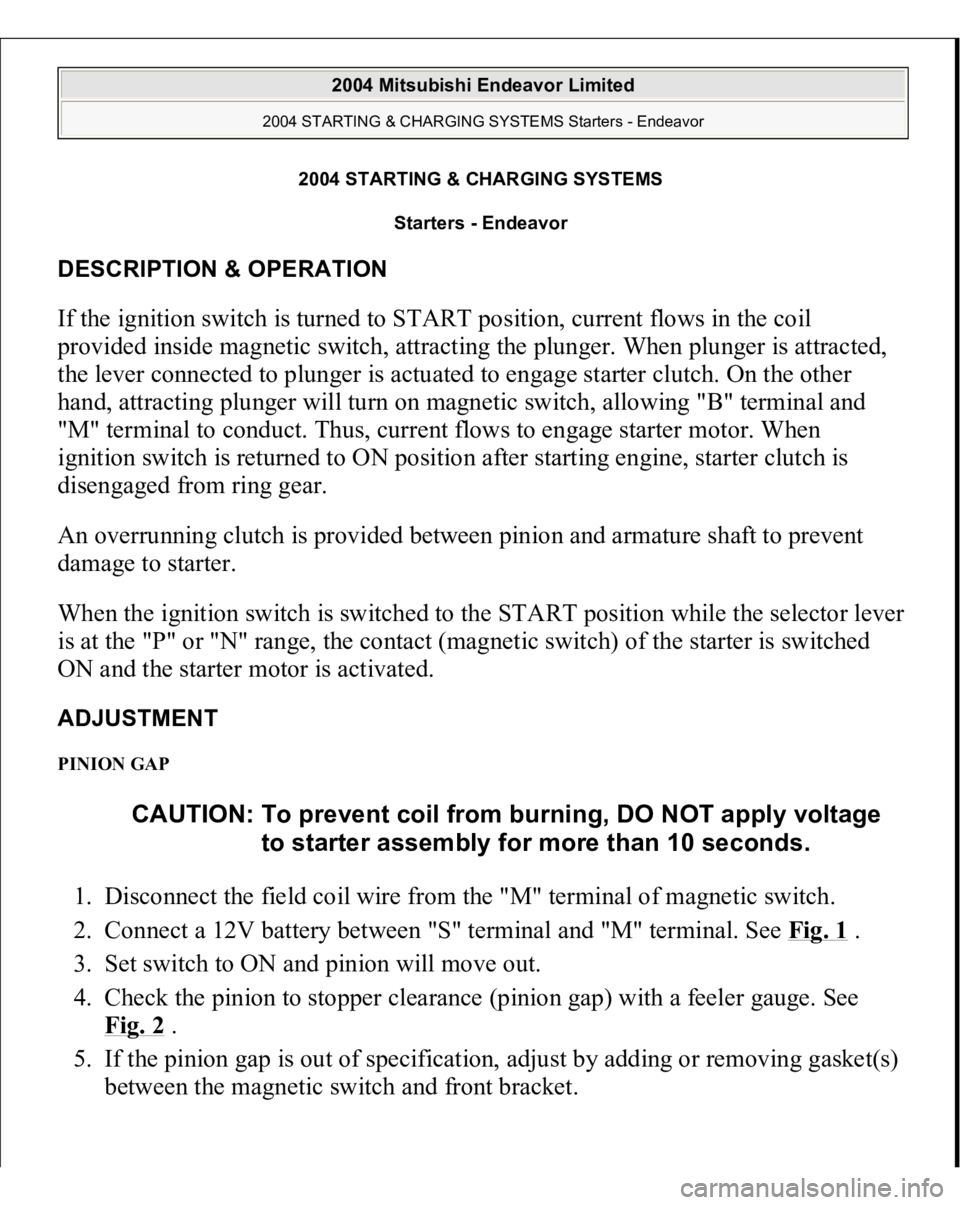
2004 STARTING & CHARGING SYSTEMS
Starters - Endeavor
DESCRIPTION & OPERATION If the ignition switch is turned to START position, current flows in the coil
provided inside magnetic switch, attracting the plunger. When plunger is attracted,
the lever connected to plunger is actuated to engage starter clutch. On the other
hand, attracting plunger will turn on magnetic switch, allowing "B" terminal and
"M" terminal to conduct. Thus, current flows to engage starter motor. When
ignition switch is returned to ON position after starting engine, starter clutch is
disengaged from ring gear.
An overrunning clutch is provided between pinion and armature shaft to prevent
damage to starter.
When the ignition switch is switched to the START position while the selector leve
r
is at the "P" or "N" range, the contact (magnetic switch) of the starter is switched
ON and the starter motor is activated.
ADJUSTMENT PINION GAP 1. Disconnect the field coil wire from the "M" terminal of magnetic switch.
2. Connect a 12V battery between "S" terminal and "M" terminal. See Fig. 1
.
3. Set switch to ON and pinion will move out.
4. Check the pinion to stopper clearance (pinion gap) with a feeler gauge. See
Fig. 2
.
5. If the pinion gap is out of specification, adjust by adding or removing gasket(s)
between the ma
gnetic switch and front bracket. CAUTION: To prevent coil from burning, DO NOT apply voltage
to starter assembly for more than 10 seconds.
2004 Mitsubishi Endeavor Limited
2004 STARTING & CHARGING SYSTEMS Starters - Endeavor
2004 Mitsubishi Endeavor Limited
2004 STARTING & CHARGING SYSTEMS Starters - Endeavor
Page 3537 of 3870
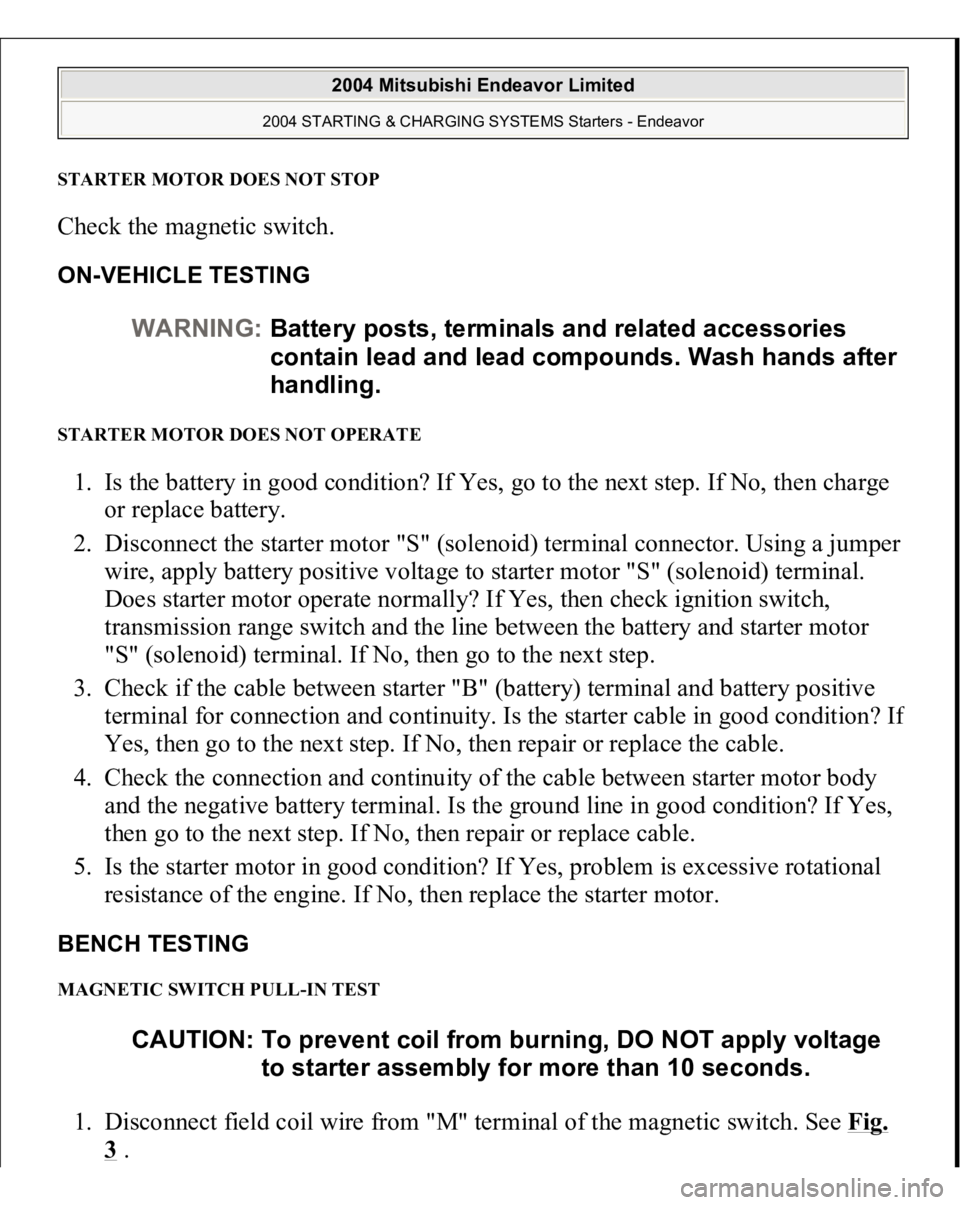
STARTER MOTOR DOES NOT STOPCheck the magnetic switch. ON-VEHICLE TESTING STARTER MOTOR DOES NOT OPERATE 1. Is the battery in good condition? If Yes, go to the next step. If No, then charge
or replace battery.
2. Disconnect the starter motor "S" (solenoid) terminal connector. Using a jumper
wire, apply battery positive voltage to starter motor "S" (solenoid) terminal.
Does starter motor operate normally? If Yes, then check ignition switch,
transmission range switch and the line between the battery and starter motor
"S" (solenoid) terminal. If No, then go to the next step.
3. Check if the cable between starter "B" (battery) terminal and battery positive
terminal for connection and continuity. Is the starter cable in good condition? I
f
Yes, then go to the next step. If No, then repair or replace the cable.
4. Check the connection and continuity of the cable between starter motor body
and the negative battery terminal. Is the ground line in good condition? If Yes,
then go to the next step. If No, then repair or replace cable.
5. Is the starter motor in good condition? If Yes, problem is excessive rotational
resistance of the engine. If No, then replace the starter motor.
BENCH TESTING MAGNETIC SWITCH PULL-IN TEST 1. Disconnect field coil wire from "M" terminal of the magnetic switch. See Fig.
3 . WARNING:Battery posts, terminals and related accessories
contain lead and lead compounds. Wash hands after
handling.
CAUTION: To prevent coil from burning, DO NOT apply voltage
to starter assembly for more than 10 seconds.
2004 Mitsubishi Endeavor Limited
2004 STARTING & CHARGING SYSTEMS Starters - Endeavor
Page 3572 of 3870
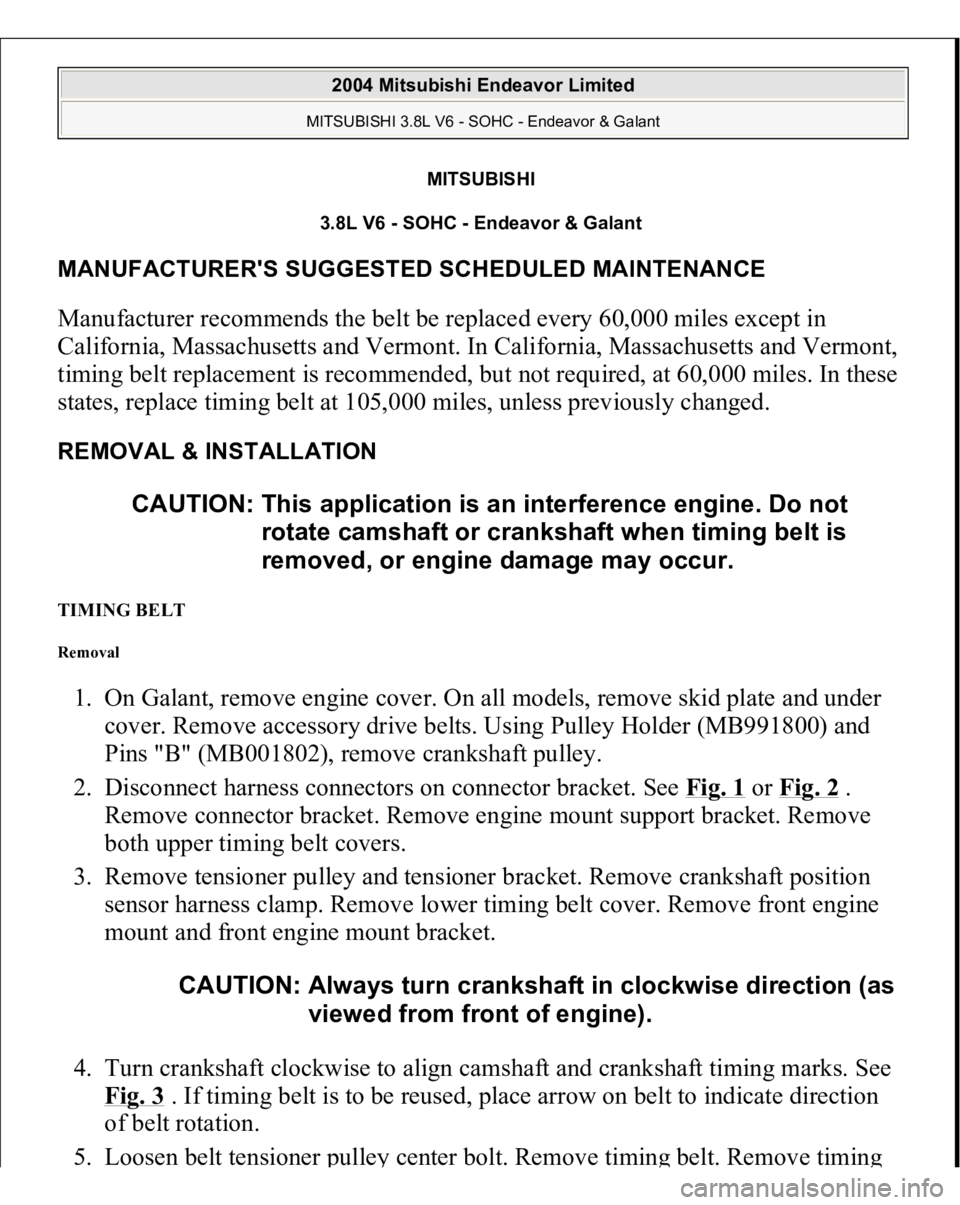
MITSUBISHI
3.8L V6 - SOHC - Endeavor & Galant
MANUFACTURER'S SUGGESTED SCHEDULED MAINTENANCE Manufacturer recommends the belt be replaced every 60,000 miles except in
California, Massachusetts and Vermont. In California, Massachusetts and Vermont,
timing belt replacement is recommended, but not required, at 60,000 miles. In these
states, replace timing belt at 105,000 miles, unless previously changed. REMOVAL & INSTALLATION TIMING BELT Removal 1. On Galant, remove engine cover. On all models, remove skid plate and under
cover. Remove accessory drive belts. Using Pulley Holder (MB991800) and
Pins "B" (MB001802), remove crankshaft pulley.
2. Disconnect harness connectors on connector bracket. See Fig. 1
or Fig. 2
.
Remove connector bracket. Remove engine mount support bracket. Remove
both upper timing belt covers.
3. Remove tensioner pulley and tensioner bracket. Remove crankshaft position
sensor harness clamp. Remove lower timing belt cover. Remove front engine
mount and front engine mount bracket.
4. Turn crankshaft clockwise to align camshaft and crankshaft timing marks. See
Fig. 3
. If timing belt is to be reused, place arrow on belt to indicate direction
of belt rotation.
5. Loosen belt tensioner
pulle
y center bolt. Remove timin
g belt. Remove timin
g CAUTION: This application is an interference engine. Do not
rotate camshaft or crankshaft when timing belt is
removed, or engine damage may occur.
CAUTION: Always turn crankshaft in clockwise direction (as
viewed from front of engine).
2004 Mitsubishi Endeavor Limited MITSUBISHI 3.8L V6 - SOHC - Endeavor & Galant
2004 Mitsubishi Endeavor Limited MITSUBISHI 3.8L V6 - SOHC - Endeavor & Galant
Page 3577 of 3870
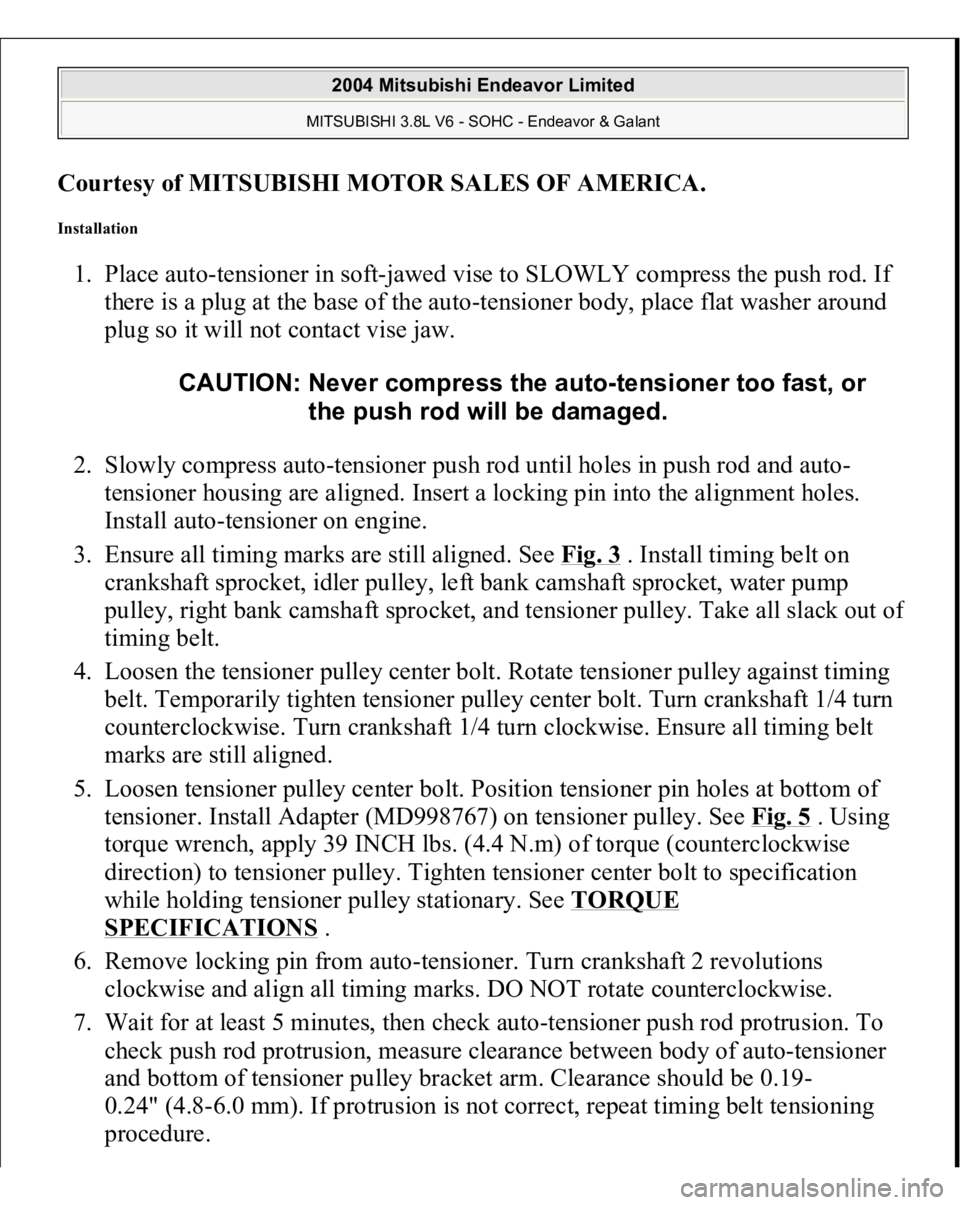
Courtesy of MITSUBISHI MOTOR SALES OF AMERICA
.
Installation 1. Place auto-tensioner in soft-jawed vise to SLOWLY compress the push rod. If
there is a plug at the base of the auto-tensioner body, place flat washer around
plug so it will not contact vise jaw.
2. Slowly compress auto-tensioner push rod until holes in push rod and auto-
tensioner housing are aligned. Insert a locking pin into the alignment holes.
Install auto-tensioner on engine.
3. Ensure all timing marks are still aligned. See Fig. 3
. Install timing belt on
crankshaft sprocket, idler pulley, left bank camshaft sprocket, water pump
pulley, right bank camshaft sprocket, and tensioner pulley. Take all slack out o
f
timing belt.
4. Loosen the tensioner pulley center bolt. Rotate tensioner pulley against timing
belt. Temporarily tighten tensioner pulley center bolt. Turn crankshaft 1/4 turn
counterclockwise. Turn crankshaft 1/4 turn clockwise. Ensure all timing belt
marks are still aligned.
5. Loosen tensioner pulley center bolt. Position tensioner pin holes at bottom of
tensioner. Install Adapter (MD998767) on tensioner pulley. See Fig. 5
. Using
torque wrench, apply 39 INCH lbs. (4.4 N.m) of torque (counterclockwise
direction) to tensioner pulley. Tighten tensioner center bolt to specification
while holding tensioner pulley stationary. See TORQUE
SPECIFICATIONS
.
6. Remove locking pin from auto-tensioner. Turn crankshaft 2 revolutions
clockwise and align all timing marks. DO NOT rotate counterclockwise.
7. Wait for at least 5 minutes, then check auto-tensioner push rod protrusion. To
check push rod protrusion, measure clearance between body of auto-tensioner
and bottom of tensioner pulley bracket arm. Clearance should be 0.19-
0.24" (4.8-6.0 mm). If protrusion is not correct, repeat timing belt tensioning
procedure. CAUTION: Never compress the auto-tensioner too fast, or
the push rod will be damaged.
2004 Mitsubishi Endeavor Limited MITSUBISHI 3.8L V6 - SOHC - Endeavor & Galant
Page 3579 of 3870
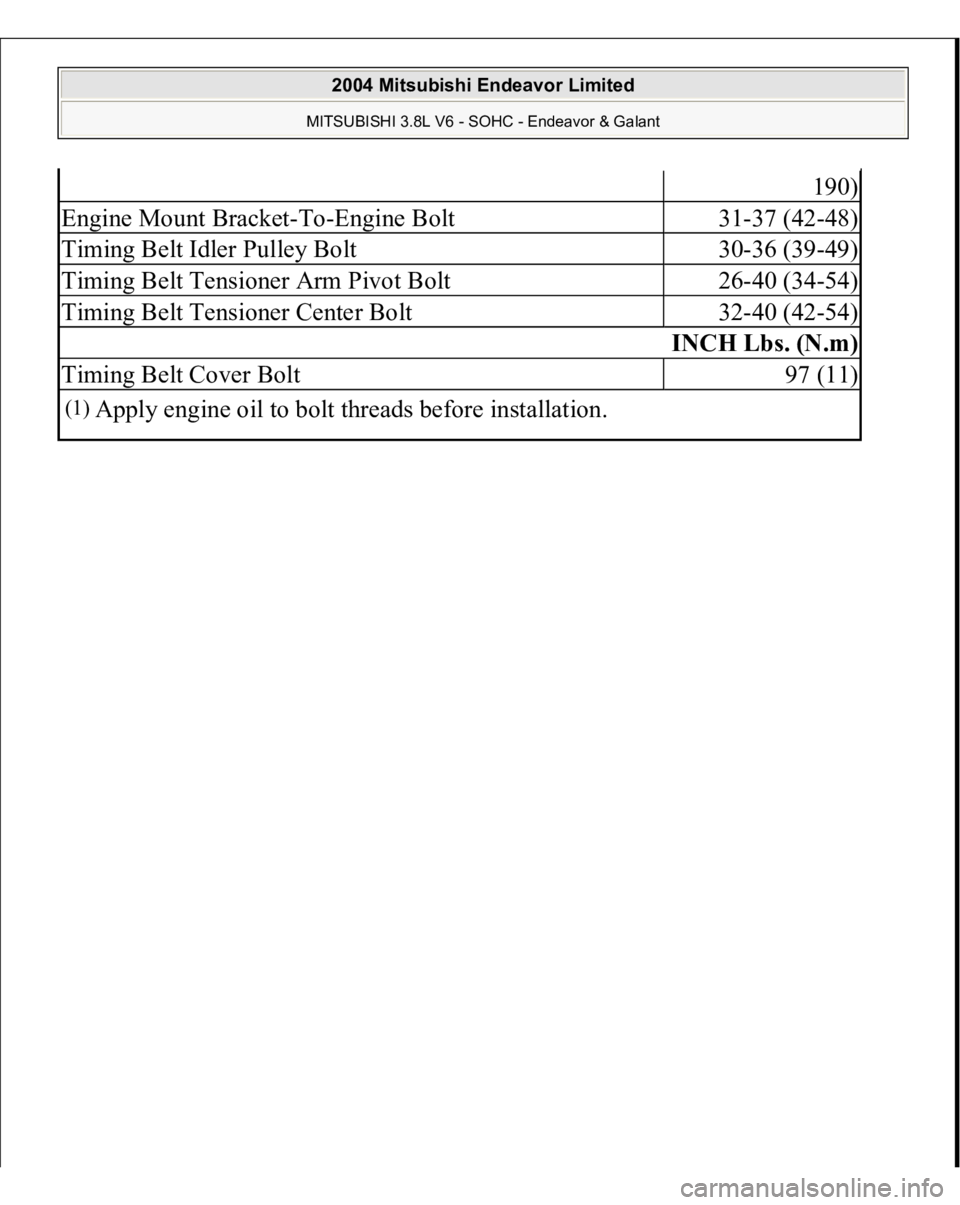
190)
Engine Mount Bracket-To-Engine Bolt
31-37 (42-48)
Timing Belt Idler Pulley Bolt
30-36 (39-49)
Timing Belt Tensioner Arm Pivot Bolt
26-40 (34-54)
Timing Belt Tensioner Center Bolt
32-40 (42-54)
INCH Lbs. (N.m)
Timing Belt Cover Bolt
97 (11)
(1)
Apply engine oil to bolt threads before installation.
2004 Mitsubishi Endeavor Limited MITSUBISHI 3.8L V6 - SOHC - Endeavor & Galant
Page 3580 of 3870
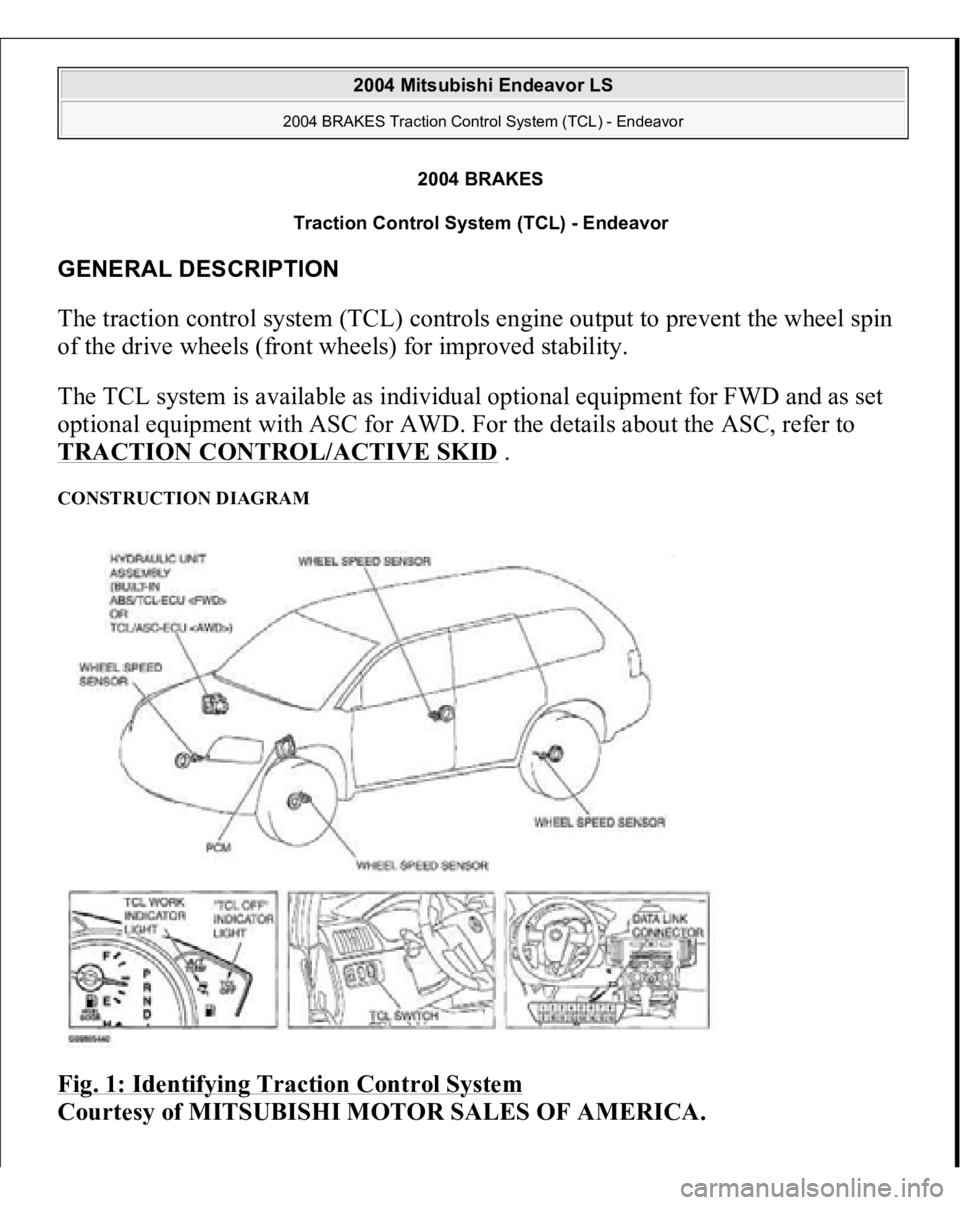
2004 BRAKES
Traction Control System (TCL) - Endeavor
GENERAL DESCRIPTION The traction control system (TCL) controls engine output to prevent the wheel spin
of the drive wheels (front wheels) for improved stability.
The TCL system is available as individual optional equipment for FWD and as set
optional equipment with ASC for AWD. For the details about the ASC, refer to
TRACTION CONTROL/ACTIVE SKID
.
CONSTRUCTION DIAGRAM Fig. 1: Identifying Traction Control System
Courtes
y of MITSUBISHI MOTOR SALES OF AMERICA
.
2004 Mitsubishi Endeavor LS
2004 BRAKES Traction Control System (TCL) - Endeavor
2004 Mitsubishi Endeavor LS
2004 BRAKES Traction Control System (TCL) - Endeavor
Page 3581 of 3870
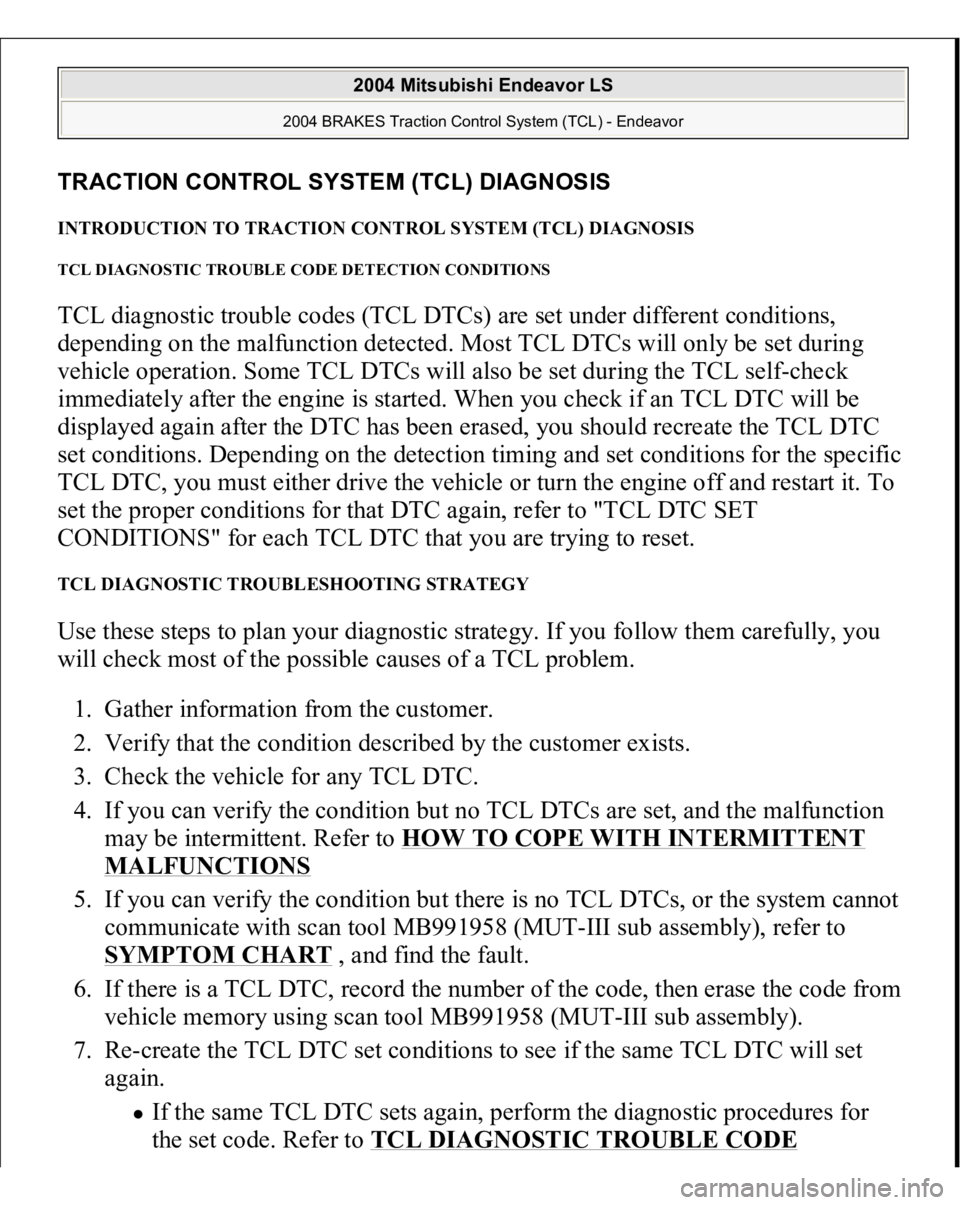
TRACTION CONTROL SYSTEM (TCL) DIAGNOSIS INTRODUCTION TO TRACTION CONTROL SYSTEM (TCL) DIAGNOSIS TCL DIAGNOSTIC TROUBLE CODE DETECTION CONDITIONS TCL diagnostic trouble codes (TCL DTCs) are set under different conditions,
depending on the malfunction detected. Most TCL DTCs will only be set during
vehicle operation. Some TCL DTCs will also be set during the TCL self-check
immediately after the engine is started. When you check if an TCL DTC will be
displayed again after the DTC has been erased, you should recreate the TCL DTC
set conditions. Depending on the detection timing and set conditions for the specific
TCL DTC, you must either drive the vehicle or turn the engine off and restart it. To
set the proper conditions for that DTC again, refer to "TCL DTC SET
CONDITIONS" for each TCL DTC that you are trying to reset. TCL DIAGNOSTIC TROUBLESHOOTING STRATEGY Use these steps to plan your diagnostic strategy. If you follow them carefully, you
will check most of the possible causes of a TCL problem.
1. Gather information from the customer.
2. Verify that the condition described by the customer exists.
3. Check the vehicle for any TCL DTC.
4. If you can verify the condition but no TCL DTCs are set, and the malfunction
may be intermittent. Refer to HOW TO COPE WITH INTERMITTENT
MALFUNCTIONS
5. If you can verify the condition but there is no TCL DTCs, or the system cannot
communicate with scan tool MB991958 (MUT-III sub assembly), refer to
SYMPTOM CHART , and find the fault.
6. If there is a TCL DTC, record the number of the code, then erase the code from
vehicle memory using scan tool MB991958 (MUT-III sub assembly).
7. Re-create the TCL DTC set conditions to see if the same TCL DTC will set
again.
If the same TCL DTC sets again, perform the diagnostic procedures for
the set code. Refer to TCL DIAGNOSTIC TROUBLE CODE
2004 Mitsubishi Endeavor LS
2004 BRAKES Traction Control System (TCL) - Endeavor
Page 3596 of 3870
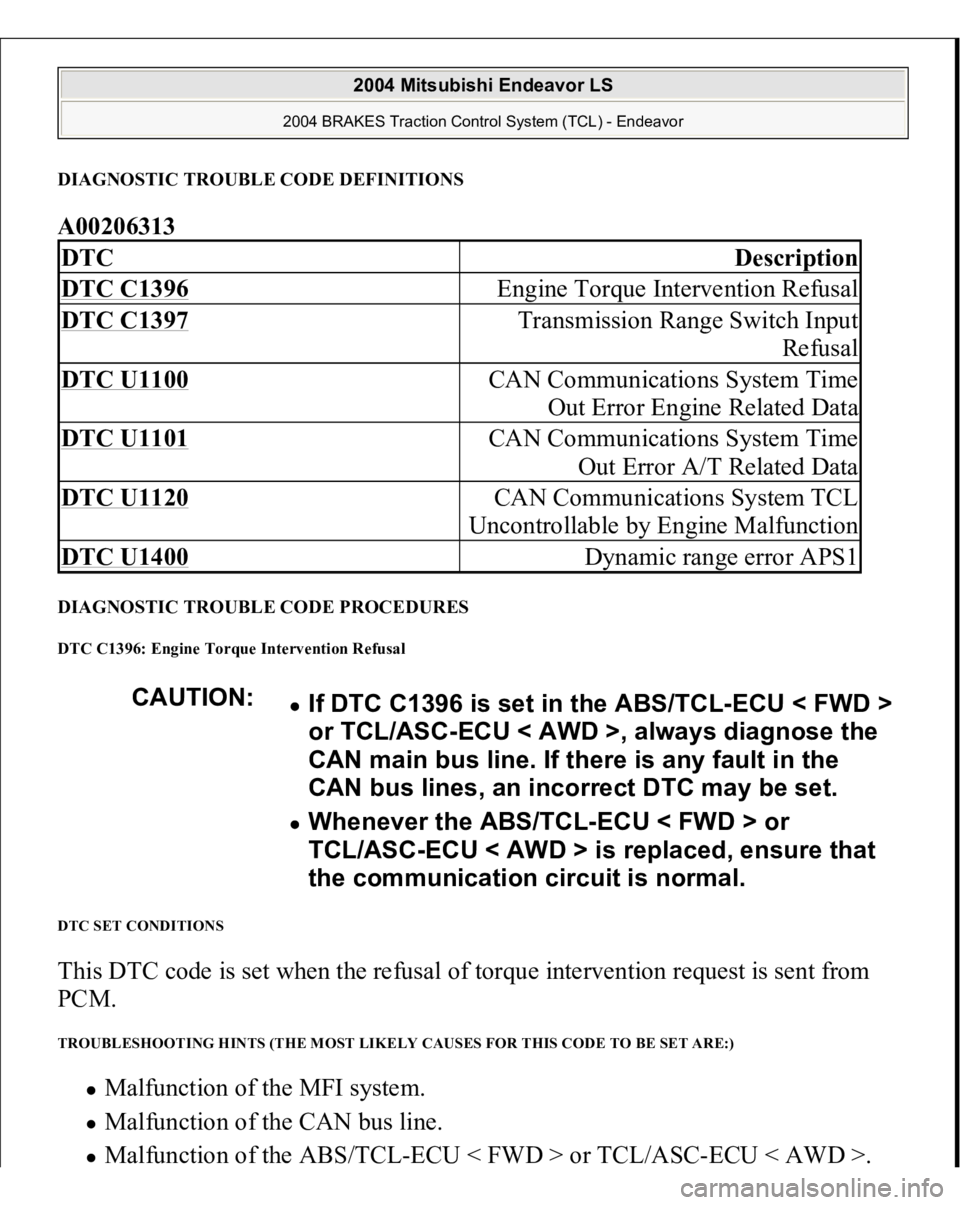
DIAGNOSTIC TROUBLE CODE DEFINITIONSA00206313 DIAGNOSTIC TROUBLE CODE PROCEDURES DTC C1396: Engine Torque Intervention Refusal DTC SET CONDITIONS This DTC code is set when the refusal of torque intervention request is sent from
PCM. TROUBLESHOOTING HINTS (THE MOST LIKELY CAUSES FOR THIS CODE TO BE SET ARE:)
Malfunction of the MFI system. Malfunction of the CAN bus line. Malfunction of the ABS/TC
L-ECU < FWD > or TCL/ASC-ECU < AWD >.
DTC
Description
DTC C1396
Engine Torque Intervention Refusal
DTC C1397
Transmission Range Switch Input
Refusal
DTC U1100
CAN Communications System Time
Out Error Engine Related Data
DTC U1101
CAN Communications System Time
Out Error A/T Related Data
DTC U1120
CAN Communications System TCL
Uncontrollable by Engine Malfunction
DTC U1400
Dynamic range error APS1
CAUTION:
If DTC C1396 is set in the ABS/TCL-ECU < FWD >
or TCL/ASC-ECU < AWD >, always diagnose the
CAN main bus line. If there is any fault in the
CAN bus lines, an incorrect DTC may be set. Whenever the ABS/TCL-ECU < FWD > or
TCL/ASC-ECU < AWD > is replaced, ensure that
the communication circuit is normal.
2004 Mitsubishi Endeavor LS
2004 BRAKES Traction Control System (TCL) - Endeavor